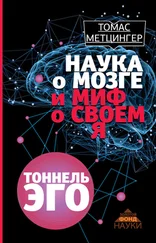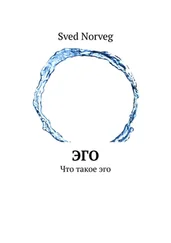Томас Метцингер - Туннель Эго
Здесь есть возможность читать онлайн «Томас Метцингер - Туннель Эго» весь текст электронной книги совершенно бесплатно (целиком полную версию без сокращений). В некоторых случаях можно слушать аудио, скачать через торрент в формате fb2 и присутствует краткое содержание. Жанр: Биология, на русском языке. Описание произведения, (предисловие) а так же отзывы посетителей доступны на портале библиотеки ЛибКат.
- Название:Туннель Эго
- Автор:
- Жанр:
- Год:неизвестен
- ISBN:нет данных
- Рейтинг книги:4 / 5. Голосов: 1
-
Избранное:Добавить в избранное
- Отзывы:
-
Ваша оценка:
- 80
- 1
- 2
- 3
- 4
- 5
Туннель Эго: краткое содержание, описание и аннотация
Предлагаем к чтению аннотацию, описание, краткое содержание или предисловие (зависит от того, что написал сам автор книги «Туннель Эго»). Если вы не нашли необходимую информацию о книге — напишите в комментариях, мы постараемся отыскать её.
Thomas Metzinger — The Ego Tunnel. The Science Of The Mind and The Myth Of The Self
Перевод с английского: Вячеслав Михайлов http://www.nwethik.com
Туннель Эго — читать онлайн бесплатно полную книгу (весь текст) целиком
Ниже представлен текст книги, разбитый по страницам. Система сохранения места последней прочитанной страницы, позволяет с удобством читать онлайн бесплатно книгу «Туннель Эго», без необходимости каждый раз заново искать на чём Вы остановились. Поставьте закладку, и сможете в любой момент перейти на страницу, на которой закончили чтение.
Интервал:
Закладка:
Примечания
INTRODUCTION
1. M. Botvinick & J. Cohen, «Rubber Hand 'Feels' Touch That Eyes See,» Nature ШН: ШН (ИШН).
2. B. Lenggenhager et al., «Video Ergo Sum: Manipulating Bodily SelfConsciousness,» Science .
3. For a concise conceptual interpretation, see O. Blanke & T. Metzinger, «Full-body Illusions and Minimal Phenomenal Selfhood,» Trends Cog. Sci.
4. «Transparency» is a technical term in the modern philosophy of mind; a conscious representation is transparent if the system using it cannot, by means of introspection alone, recognize it as a representation. As philosophers might say, we see only the content, never the carrier-only «intentional properties» are accessible to introspection. Subjectively, this creates the feeling of being in direct contact with reality.
5. Thomas Metzinger, Being No One: The Self-Model Theory of Subjectivity (Cambridge, MA: MIT Press). The shortest freely available summary can be found in Scholarpedia Н(НН):ИШН, at www.scholarpedia.org/article/Self_Models; for overviews, see Metzinger, Precis of «Being No One,» Psyche ), at http://psyche.cs.monash.edu.au/symposia/metzinger/precis.pdf; and Metzinger, «Empirical Perspectives from the SelfModel Theory of Subjectivity,» Progress in Brain Res. (electronic offprint available from author).
CHAPTER 1
I. See T. Metzinger, «Beweislast fur Fleischesser,» Gehirn & Geist 5:70–75 (2006), reprinted in C. Konneker, Wer erklart den Menschen? Hirnforscher, Psychologen und Philosophen im Dialog (Frankfurt am Main: Fischer, 2006); A. K. Seth et al., «Criteria for Consciousness in Humans and Other Mammals,» Consciousness and Cognition 14:119–139 (2005); and D. B. Edelman et al., «Identifying Hallmarks of Consciousness in Non-Mammalian Species,» Consciousness and Cognition 14:169–187 (2005). Octopi are particularly interesting, because their brain architecture is very different from that of mammals, but they turn out to be much smarter than was assumed in the past. Although cognitive complexity perse is not an argument for the existence of subjective experience, we now have evidence that makes at least primary consciousness quite plausible in octopi; see J. A. Mather, «Celaphod Consciousness: Behavioural Evidence,» Consciousness and Cognition 17:37–48 (2008).
2. See Patrick Wilken, «ASSC-10 Welcoming address,» in 10th Annual Meeting of the Association for the Scientific Study of Consciousness, 23–36 June 2006, Oxford, U.K., 6. At http://eprints.assc.caltech.edu/138/01/ASSC10_welcome_final.pdf.
3. See Thomas Metzinger, ed., Conscious Experience (Thorverton, UK, and Paderborn, Germany: mentis & Imprint Academic, 1995).
4. See the special issue on the neurobiology of animal consciousness in Consciousness and Cognition 14(1):1-232 (2005), in particular A. K. Seth et al., «Criteria for Consciousness in Humans and Other Mammals,» 119–139.
5. See Thomas Metzinger, ed., Neural Correlates of Consciousness: Empirical and Conceptual Questions (Cambridge, MA: MIT Press, 2000).
6. See Colin McGinn, «Can We Solve the Mind-Body Problem?» Mind 98:349–366 (1989). Reprinted in Ned Block et al., eds., The Nature of Consciousness: Philosophical Debates (Cambridge, MA: MIT Press, 1997); and Metzinger, «Introduction: Consciousness Research at the End of the Twentieth Century,» in Metzinger, ed., Neural Correlates of Consciousness (2000).
7. Antti Revonsuo, Inner Presence: Consciousness as a Biological Phenomenon (Cambridge, MA: MIT Press, 2006), 144ff.
CHAPTER 2
1. In philosophical parlance, a «zombie» is a hypothetical entity that behaves exactly like a person and is objectively indistinguishable from one, but has no inner awareness of anything. If zombies were at least logically possible, this could perhaps show that there is no entailment from physical facts to facts about consciousness.
2. See, for example, Rocco J. Gennaro, ed., Higher-Order Theories of Consciousness: An Anthology (Philadelphia: John Benjamins, 2004); and David Rosenthal, Consciousness and Mind (New York: Oxford University Press, 2006).
3. See S. P. Vecera & K. S. Gilds, «What Is It Like to Be a Patient with Apperceptive Agnosia?» Consciousness and Cognition 6:237–266 (1997).
4. A. Marcel, «Conscious and Unconscious Perception: An Approach to the Relations Between Phenomenal Experience and Perceptual Processes,» Cog. Psychology 15:292 (1983).
5. See, for example, G. Tononi & G. M. Edelman, «Consciousness and Complexity,» Science 282:1846-51 (1998); and Tononi et al., «Complexity and the Integration of Information in the Brain,» Trends Cog. Sci. 2:44–52 (1998). For an exciting recent application to the difference between waking and sleeping, see M. Massimini et al., «Breakdown of Cortical Effective Connectivity During Sleep,» Science 309:2228-32 (2005). For a popular description, see Edelman and Tononi, A Universe of Consciousness: How Matter Becomes Imagination (New York: Basic Books, 2000).
6. Thomas Metzinger, Being No One: The Self-Model Theory of Subjectivity (Cambridge, MA: MIT Press, 2003).
7. In Greek mythology, the analogy between sleep and death was even closer: Hypnos, the god of sleep, and Thanatos, the god of death, were twins, the sons of Nyx, the night. Morpheus, the god of dreams, was Hypnos' son. As in Shakespeare, to sleep, and possibly to die, is perchance to dream.
8. See V. A. F. Lamme, «Towards a True Neural Stance on Consciousness,» Trends Cog. Sci. 10(11):494–501 (2006); S. Dehaene et al., «Conscious, Preconscious, and Subliminal Processing: A Testable Taxonomy,» Trends Cog. Sci. 10(5):204–211 (2006).
9. A. Lutz, «Changes in the Tonic High-Amplitude Gamma Oscillations During Meditation Correlates with Long-Term Practitioners' Verbal Reports,» poster at the 9th ASSC conference, Pasadena, CA (2005); Lutz et al., «Long-Term Meditators Self-Induce High-Amplitude Synchrony During Mental Practice,» Proc. Nat. Acad. Sci. 101(46):16369-73 (2004). A good recent review is A. Lutz et al., «Attention Regulation and Monitoring in Meditation,» Trends Cog. Sci. 12(4):163–169 (2008).
10. Although I ultimately disagree with his theory of the «objective self,» perhaps the most beautiful and readable exposition of this problem and its application to self-consciousness can be found in chapter 4 of Thomas Nagel's The View from Nowhere (New York: Oxford University Press, 1986).
11. R. L. Gregory, «Visual Illusions Classified,» Trends Cog. Sci. 1:190–194 (1997).
12. Ernst Poppel, Mindworks: Time and Conscious Experience (New York: Harcourt Brace Jovanovich, 1988); E. Ruhnau, «Time-Gestalt and the Observer,» in Thomas Metzinger, ed., Conscious Experience (Thorverton, UK, and Paderborn, Germany: mentis & Imprint Academic, 1995).
13. R. M. Halsey & A. Chapanis, «Number of Absolutely Identifiable Hues,» Jour. OpticalSoc. Amer. 41(12):1057-58 (1951). For an excellent philosophical discussion, see D. Raffman, «On the Persistence of Phenomenology,» in Thomas Metzinger, ed., Conscious Experience (Thorverton, UK, and Paderborn, Germany: mentis & Imprint Academic, 1995).
14. Raffman, «On the Persistence of Phenomenology,» 295 (1995).
15. Clarence I. Lewis, Mind and the World Order (New York: Scribner's, 1929). See also Daniel C. Dennett, «Quining Qualia,» in A. J. Marcel & E. Bisiach, Consciousness in Contemporary Science (New York: Oxford University Press, 1988).
Читать дальшеИнтервал:
Закладка:
Похожие книги на «Туннель Эго»
Представляем Вашему вниманию похожие книги на «Туннель Эго» списком для выбора. Мы отобрали схожую по названию и смыслу литературу в надежде предоставить читателям больше вариантов отыскать новые, интересные, ещё непрочитанные произведения.
Обсуждение, отзывы о книге «Туннель Эго» и просто собственные мнения читателей. Оставьте ваши комментарии, напишите, что Вы думаете о произведении, его смысле или главных героях. Укажите что конкретно понравилось, а что нет, и почему Вы так считаете.








